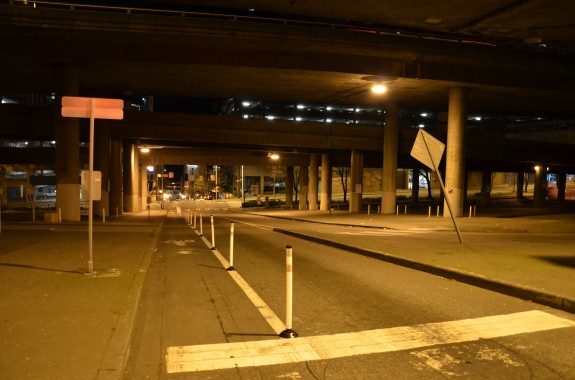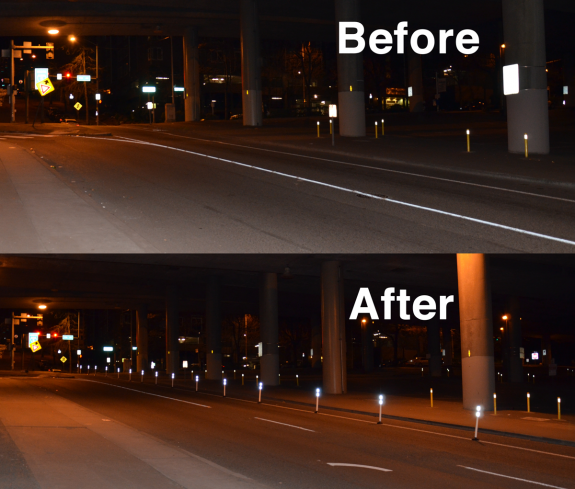Guerrilla road safety group ‘politely’ installs illegal bike lane protectors on Cherry Street
An extremely polite group of anonymous guerrilla road safety activists armed with $350 worth of reflective plastic pylons turned the painted Cherry Street bike lane under I-5 into a protected bike lane Monday morning.The group—calling themselves the Reasonably Polite Seattleites—wanted to make a statement about how easy and affordable it would be for the city to use the method to make bike lanes safer all over the city. To stress how polite they are, they attached them using an adhesive pad for easy removal, according to an email sent to SDOT and Seattle Bike Blog.
The city has removed them, but responded with an equally polite email thanking them for making the statement, apologizing that they had to remove them and even offering to give the pylons back. Below are the shockingly polite emails, starting with the RPS:
Tom, I’m an avid reader of your blog and avid cyclist. We’ve attended meetings together, though I don’t think we’ve ever actually met. I’m emailing because this morning a friend and I installed a string of plastic pylons along the Cherry Street bike lane under I-5. I’ve attached a couple of pictures. In New York, Washington, D.C., Chicago, San Francisco, Portland, the city transportation department usually installs these things, which slow traffic to the posted speed limit, and afford cyclists some protection. Some might ask, very reasonably, how does a piece of cheap plastic protect you from a drunk or distracted driver in a two ton SUV? Based on my experience commuting in such lanes in other cities, 1) they slow speeding traffic by making the lane appear narrower (without actually reducing its size); and 2) it’s essentially a warning system for a drunk or distracted driver; once he hits one, he’s more likely to slow down, lessening the chance of hitting a cyclist or pedestrian down the road. This string cost about $350 in materials and required literally 10 minutes to install (admittedly, because SPD HQ is across the street, we hurried). SDOT will probably argue maintaining these things costs money, they complicate street cleaning, etc., etc. These are reasonable arguments, except that Chicago, D.C., San Francisco have confronted and overcome the same issues.Two days later, the group received an equally-polite response from SDOT’s traffic engineer explaining why the bollards had to be removed (and offering to give them back):
We chose this block fairly arbitrarily; we certainly don’t enjoy riding it, despite the fact the bike lane is relatively new–cars race past, gaining speed for the approaching hill, or to accelerate onto I-5. The grade is inclined, so cycling is slow–thus, as cars accelerate to 45 mph, we’re moving at 4 or 5. But this certainly wasn’t the worst bike facility in Seattle. Our intention was merely to demonstrate how an incredibly modest investment and a few minutes of SDOT’s time is capable of transforming a marginal, under-utilized and dangerous bike facility into one dramatically safer for cars, pedestrians and bicyclists. (This is not mere rhetoric; as you undoubtedly know, New York City’s investments in pedestrian facilities, bike lanes and cycletracks led to the lowest number of traffic related facilities in the city’s recorded history—not per capita, but in absolute numbers, despite exponential population growth; in other words, these facilities are safer not only for pedestrians and cyclists, but drivers.)
We sincerely hope the new master bicycle plan, which currently includes 137 miles of cycletracks, is fully implemented, though we’re understandably skeptical. While we’re waiting, many obvious, inexpensive, relatively non-controversial solutions exist, as we’ve sought to demonstrate here. We wish Mayor McGinn would explore such opportunities. We wish we didn’t have to spend our own money on common-sense, unobtrusive traffic calming treatments, and risk arrest installing them, in order to feel safe riding in this city.
PS: Because we we’re still polite Seattleites (even when we engage in acts of civil disobedience), we used an adhesive pad, which is removable, not epoxy, which is more permanent, meaning Mayor McGinn and SDOT can remove these in a matter of minutes, if they so choose.
Hello reasonably polite Seattleites,
Thank you for pointing out some easy ways to calm traffic and provide more secure feeling bicycle lane on our streets. Your sentiment of unease and insecurity riding on painted bicycle lanes next to high speed and high volume traffic is exactly what I am hearing from the our residents as we update our bicycle master plan. This strong message to me and my staff that we have be more thoughtful on facility design and implementation is being heard loud and clear. You are absolutely correct that there are low cost and simple ways to slow traffic, increase the sense of protection, and provide bicycle facilities that are more pleasant and accommodating for larger portion of people who ride bicycles. I am truly appreciative that you care enough to take time, money, and risk to send your message to me and my staff. It is my commitment to you that I will do my best to update our existing facilities and install new bicycle facilities that will be more thoughtful. Some of these will be low cost, such as what you demonstrated on Cherry Street, while others will require more resources to implement.
The posts that you installed on Cherry Street will be removed and I am sorry about that. The posts are 36 inches high and is higher than most road bicycle handle bars. A rider can hit the post with their handle bar, which is a safety concern. The bicycle lane narrow and is five feet wide. The travel lane is 11 feet wide, which is what the State DOT permitted us to narrow the lane to. Cherry Street is under the freeway and is owned by the State, so we do have to get their permission for reconfiguring the street. If we had more lane width to work with, we could installed shorter posts. Unfortunately, this is not the case here. Please let me know if you would like the posts back and I will have the crew leave the post in a safe area for you to pick up. Thank you, again, for your thoughtful demonstration.
Sincerely,
DONGHO CHANG, PE, PTOE
City Traffic Engineer
Seattle Department of Transportation
Traffic Management Division


No comments:
Post a Comment